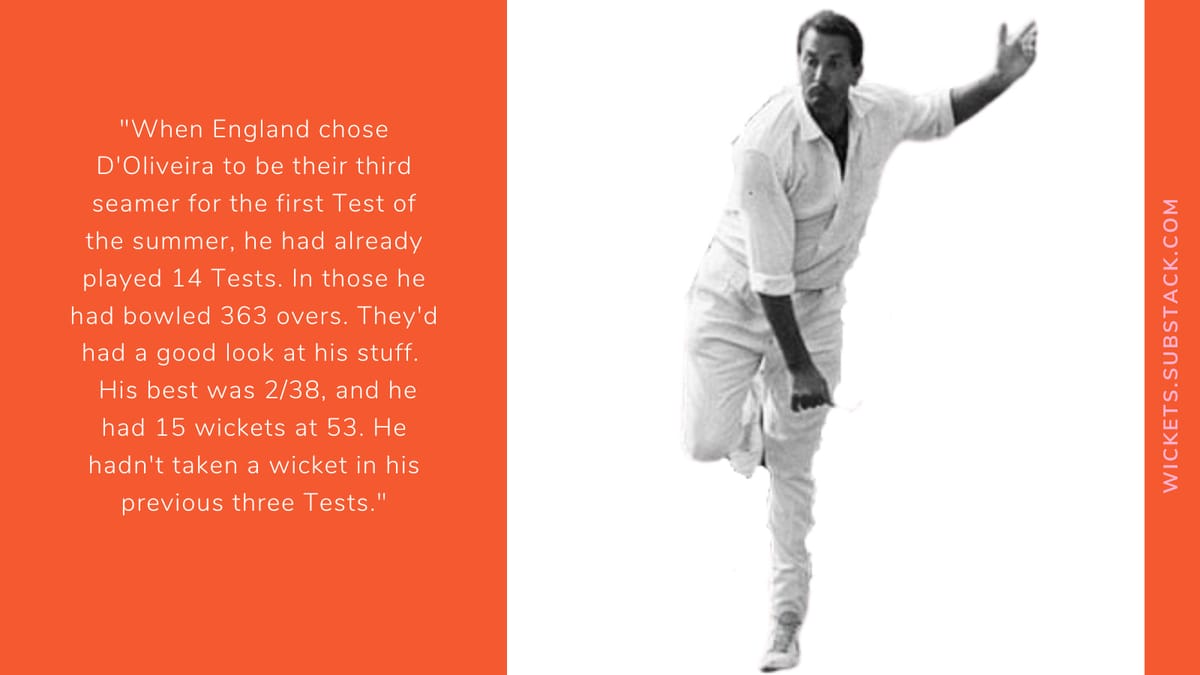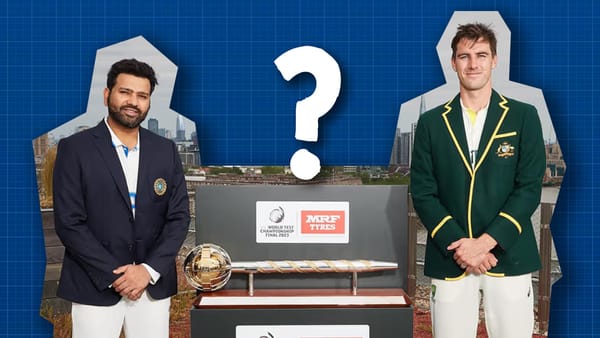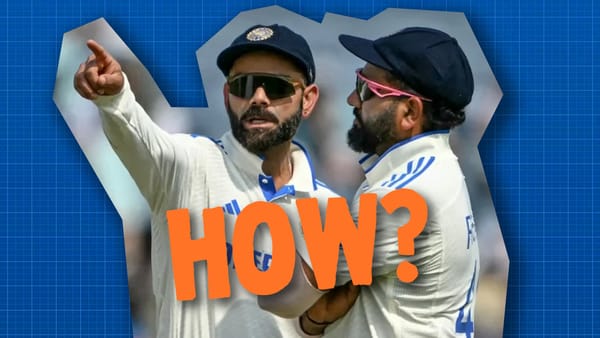Basil D'Oliveira and cricket selection
A look at the time England decided Dolly was a bowler.

Basil D'Oliveira should never have been one of England's frontline four bowlers.
This is one of thing the things I learnt when making the podcast on him for Double Century.
🎙🎙Latest Double episode - Is the Scorecard Lying? 🎧🎧
— Jarrod Kimber (@ajarrodkimber) 11:44 AM ∙ Nov 6, 2020
In 1968 Basil D’Oliveira was dropped when averaging 44 as a Test batsman and his last innings was 87*. But, in that summer, everything was more complicated. This episode I “moneyball” Dolly.
podcasts.apple.com/us/podcast/2-0…
By the time he was bowling for England, he had changed from the young Cape Town genius into every the middle-aged county trundler. There's nothing wrong with D'Oliveira's bowling as a fifth option. He could keep the runs down, nip the odd wicket, and at first class level he wasn’t bad.
In Tests he hadn’t been that good. This isn’t just a stats thing either, he was a slow medium pacer who nibbled it around a bit. He didn’t pass on eye or numbers.
When England chose D'Oliveira to be their third seamer for the first Test of the summer, he had already played 14 Tests. In those he bowled 363 overs. They'd had a good look at his stuff. His best was 2/38, and he had 15 wickets at 53. He hadn't taken a wicket in his previous three Tests.

These numbers probably suggest he wasn't much of a bowler at all, but towards the back end of his career his bowling got better, or at least, better used. But he would finish his career with 47 wickets from 44 Tests. That's good for a fifth bowler who is miserly, but it's not a first choice bowling option. If you want a modern comparison, late-career Shane Watson is probably a good fit. But at Old Trafford they asked to him to do way more than that.
These are things I found out when looking at the historic summer of 1968 for the podcast. The one where England dropped an allrounder who was averaging over 40 with the bat.
The other seam bowlers of the ‘68 Old Trafford Test are interesting. 1968 Manchester Test was the other bowlers. John Snow - who you may know nothing of - was an incredible bowler. And the second seamer was Ken Higgs.
Here is a brief Twitter thread I made about Higgs once.
Today I came across a cricketer called Ken Higgs. He was an English seamer in the 60s, and while I'd see his name before, I knew nothing of him.
— Jarrod Kimber (@ajarrodkimber) 1:06 PM ∙ Sep 1, 2020
In 15 Tests he averaged 20, and then just never played again.
In first class cricket, he took 1536 wickets at 23.
That's handy, but there is one completely awesome thing about Higgs, even though he was a seamer, his first class career lasted 38 years.
— Jarrod Kimber (@ajarrodkimber) 1:07 PM ∙ Sep 1, 2020
Starting in 58, finishing in 86.
So in 86 Leicestershire brought him back to play again when he was 49.
— Jarrod Kimber (@ajarrodkimber) 1:11 PM ∙ Sep 1, 2020
He bowled first against Yorkshire, and took 5/22.
In that game, Phil Defreitas played, who played his last fc in 05
In 1958 he played with Cyril Washrbook, who made his fc debut in 1933.
*sorry, typo, 28 years his career was.
— Jarrod Kimber (@ajarrodkimber) 1:13 PM ∙ Sep 1, 2020
Seeing a seamer take 5/22 after a four-year hiatus when they're nearly 50 does disrupt your fingers.
Would have loved to be in the Leicestershire selection meeting where they decided to bring in a 49-year-old seamer four years after retirement.
— Jarrod Kimber (@ajarrodkimber) 1:21 PM ∙ Sep 1, 2020
"What we need is some experience in this team"
"How much?"
"A lot!"
"Oh, I got just the guy..."
In Higgs' last game, he took the new ball in both innings.
— Jarrod Kimber (@ajarrodkimber) 1:28 PM ∙ Sep 1, 2020
He also once put on 128 for the last wicket in a Test.
h/t @lyallsteve
theguardian.com/sport/2018/jan…
Someone should name an ice cream flavour after him.
That first Test at Old Trafford was Higgs last. They do not mention him at all in the Wisden report. Remember, unlike D'Oliveira he was a full time bowler, with an already great short Test record, and in this match he bowled 58.3 overs, taking 2/121.
D'Oliveira had 1/38 from 25 overs in the first innings and 1/7 from 5 in the second. They took him off in that last innings after taking the wicket of someone as good as Bill Lawry, which is bizarre. 2/45 at a miserly rate would have been outstanding for D'Oliveira normally. When you put that together with his 87* - coming when the game was all but lost - it should have been enough to get him another Test.
Instead he was dropped the morning of the second for Barry Knight.
Knight made 27* in the first innings, and then took 3/16 and 0/35 in the second; he didn’t bat again. That 3/16 was good, but Australia were 3/23 when he came on, they were mid collapse, and he picked up a few quick wickets. His 27 not out was decent, and long, but England were 271/5 when he walked to the wicket. That is not to downplay his performance, but it's weird how one man was talked up, and the other down, when I'd suggest they had pretty similar games. The Wikipedia entry on Knight for that Test says, "The replacement for D'Oliveira, Barry Knight, performed well in the second Test."
The politics of this is something I talk about in the podcast. The non-white player needing to be near perfect, while the white player just being handy was enough.
Knight took one more wicket in his following game Test, added 7 more runs from two more innings, and he was dropped as well.
Selection in that series was so random from England and looking back you can see why. I could use cricinfo or cricket archive to bring all this up pretty easily. Now that there are analysts in the game like me, what to look for is not that tricky once you get used to it. There is also the footage, any English selector who can't trek out to grounds can at least see footage of each player if they need too. And the ECB would thoroughly look at any prospects now before they are chosen. That doesn't mean they will always get it right, selection is still trying to tell the future, and not many of us do that well. But there is at least a plan and information.
For instance, I think now if you were looking to see if your allrounder could step is usage and bowl more, wickets per match is pretty good. D’Oliveira took barely one scalp per mTest, and 1.5 in first class cricket. He doubled his normal output when England needed too. He also had an incredible economy rate, going at under two an over when the other bowlers went for over three. You'd have to suggest he probably did about as good as you could have hoped.
And they dropped him.
But I don't think teams - let alone the media and fans - looked at things like this. England used 20 players in that series. I didn't find evidence of a rash of injuries to justify it. Knight and D'Oliveira were both dropped for instance. There is a funny story of a player dropping himself later in the series to protect his spot for a future tour. It looks to me as if the selectors were very poor at their jobs and weren't really keeping on top of the task.
Now if that is how they were looking at normal cricket decisions, then you can see how woefully inadequate this process would have been once the South African government and key MCC officials got involved in ensuring D'Oliveira didn't stay in the squad for South Africa.
Basil D'Oliveira should never have played as a frontline bowling option in the Old Trafford Test of ‘68, and he should never have been dropped because of it. Both of these things are true, and show what a bizarre time it was for English cricket.
The full Double Century Podcast can be found wherever you find podcasts.
Don’t forget to listen to the Meg Lanning podcast on Red Inker, which is a real good one.
And if you want to know more about how I went from parking cars (poorly) to all this other stuff, I talked about that on the Final Word this week.
I'm not telling anyone to turn CNN off. But, when you next need a breather, a new Story Time is up. Albert Trott, Norm O'Neill, Blocka Wilson, the Bulawayo draw - it's all here. Also, 80 mins of POWER with @ajarrodkimber from the Calling the Shots doco.
— Adam Collins (@collinsadam) 10:16 AM ∙ Nov 7, 2020
🎧omny.fm/shows/the-fina…




